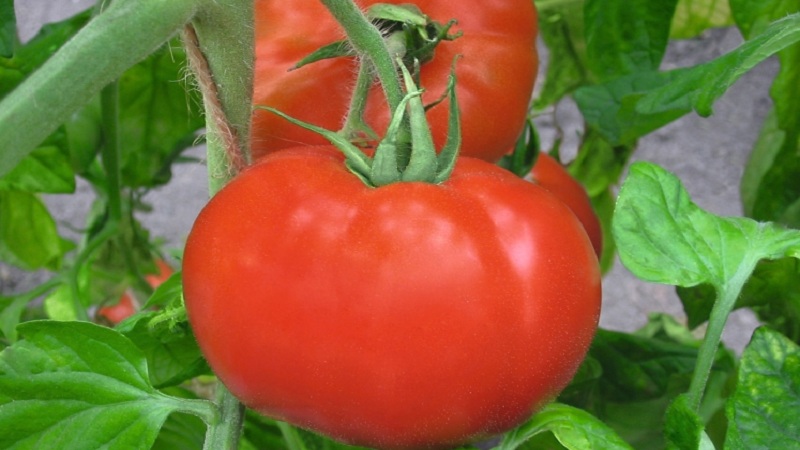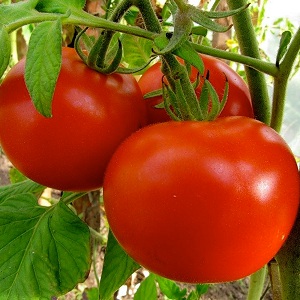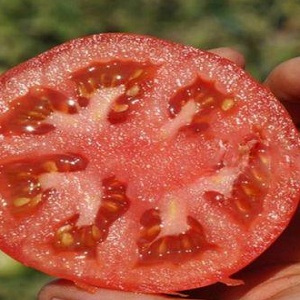An early ripe hybrid for the southern regions of the country - tomato "Polonaise f1" and the secrets of increasing its yield
Tomatoes Polonaise f1 is an ultra-early ripe hybrid bred by Dutch breeders. It is grown outdoors in southern regions and in greenhouses in areas with harsher climates. The culture is distinguished by unpretentious care, resistance to diseases of a viral nature.
In this article, we will talk about the characteristics of tomatoes, the features of agricultural technology in open and closed ground.
The content of the article
Description of the hybrid
The Dutch hybrid Polonez f1 is a breeding product of the Bejo Zaden company. Included in the State Register of Selective Achievements of the Russian Federation in 2010. Plant determinant, with a powerful root system, thick stems.
In the photo - Tomatoes Polonaise f1.

Distinctive features
The table contains the main characteristics of the Polonez hybrid.
| Indicators | Characteristic |
| Weight | 150-200 g |
| The form | Flat-round, medium-silver |
| Coloration | Red, without green spot at the stalk |
| Leaves | Medium green |
| Inflorescence type | Plain |
| Number of nests | 4 to 6 |
| Pulp | Medium density with 4-6 chambers |
| Taste | Sweet, with a pleasant sourness |
| Skin | Medium density, easily separates from the pulp |
| Appointment | For fresh consumption |
| Bushes height | 80 cm in the garden, up to 1 m - in the greenhouse |
| Ripening period | 62-65 days |
| Yield | 4-6 kg / m² |
| Sustainability | To verticillus and fusarium wilting, tobacco mosaic virus |
| Transportability | High |
Growing seedlings
Tomatoes Polonaise are among the ultra-early ripening tomatoes. Sowing for seedlings is done in March, two months before transfer to the ground.
Preparation of seeds and soil for sowing
Hybrid seeds are disinfected in production, so they do not need to be soaked in disinfecting compounds. In addition, the seed germinates quickly.
The soil for sowing seeds is prepared independently from black soil, peat, humus, mixed in equal amounts. Then add 20 g of superphosphate and wood ash for every 10 kg. Ready-made soil mixture for tomatoes from stores is also suitable. It already has all the nutrients it needs.
The soil is calcined in advance in the microwave, oven or poured with a strong solution potassium permanganate.
The seedling boxes are filled with moist soil and grooves are made 1.5 cm. The seeds are laid out at a distance of 2 cm and sprinkled on top with a layer of earth. Pour warm water using a syringe or spray bottle and cover with foil or glass to create a greenhouse effect.
Seedlings appear at an air temperature of +25 ° C in 4-5 days. The soil is ventilated daily for 15–20 minutes to prevent mold growth.
Seedling care
After the sprouts appear, the boxes are taken out to a well-lit place, the film or glass is removed. So that the seedlings do not stretch upwards with a lack of sunlight, phytolamps are placed next to it.
Seedlings are watered as the top layer of the earth dries up.
A dive into individual containers made of peat or plastic is carried out after the appearance of 2-3 true leaves.
Thanks to the efforts of biologists, Polonaise tomato seedlings grow strong without additional fertilizing.
Advice... A week before planting seedlings in the ground, take containers to fresh air for hardening for 15-30 minutes.
Cultivation of tomatoes
The early ripe hybrid Polonaise is easy to grow and care for.The culture loves moderate watering and mineral fertilizing. It is characterized by resistance to most viral diseases of nightshade.
Landing
The transfer of seedlings to open and closed ground begins in May. The timing depends on the region of cultivation. In the southern regions, tomato bushes are planted after the soil warms up to +15 ° C (in the second or third decade). In the northern latitudes, tomatoes are grown only in greenhouses, so they are planted in early May.
No more than three bushes are placed on 1 m². Wells for seedlings are dug 20 cm deep and disinfected with a hot solution of potassium permanganate. The seedlings are watered abundantly with warm water and transferred along with an earthen clod.
The beds are sprinkled with mulch - peat, sawdust or hay. This allows you to retain moisture in the soil and prevent weed growth.
Care
Five days after planting, the first watering is performed with settled or rainwater. Then the soil is moistened once a week at the rate of 5 liters of water per 1 m².
Weeding and loosening are mandatory after watering.
For a short growing season, tomatoes are fertilized three times:
- The first portion is nitrogenous fertilizers two weeks after planting: 40 g of nitrophoska, 20 chicken manure per 1 liter of water, then the volume is brought to 10 liters.
- The second portion - potassium-phosphorus feeding 10 days after the first: 10 g of superphosphate, 20 g of chicken manure are taken for 1 liter of water, the volume is brought to 10 liters. Consumption - 5 l / m².
- The third portion is potassium-phosphorus fertilizer (for 10 liters of water, 20 g of superphosphate, 40 g of ash) two weeks after the second feeding. Consumption - 5 l / m².
Growing features
A distinctive feature of the Polonez hybrid is its adaptability to cultivation in the southern regions under the open sky. A large amount of green mass protects the fruits from direct sunlight. The life processes of plants are less active in comparison with varieties and hybrids intended for the northern regions. At the same time, southern tomatoes are better adapted to changing weather conditions.
Important! For comparison: “northern” tomatoes are not suitable for outdoor cultivation in southern regions due to the small amount of greenery. They quickly burn out under the scorching rays, they cannot provide the fruits with the necessary nutrition.
The Polonez hybrid can be grown in greenhouses in the middle and northern bands. The ovaries on the bushes are formed simultaneously even at low temperatures, which ensures a harmonious return of the crop.
Diseases and pests
Tomatoes are resistant to verticillium, fusarium wilting, the tobacco mosaic virus.
Due to early ripening, they do not have time to become infected with late blight, but prevention will not hurt, since the bushes bear fruit until the end of August. To do this, greenhouses are fumigated with sulfur sticks, the land in the garden is cultivated copper sulfate and mulched with sawdust, pine needles, hay or peat.
The disease can be recognized by brown spots with a gray tint on the leaves, stems, fruits, and white bloom on the back of the leaves. Means "Fitosporin", "Ridomil Gold", "Quadris", "Baktofit" will help you quickly get rid of late blight.
To combat spider mites, aphids, whiteflies, the preparations Fitoverm, Flumite, Epin, and Zircon are used.
In the fight against insects, folk remedies are no less effective:
- 100 g of dry chamomile flowers are poured into 1 liter of warm water, insisted for 10 hours. Then the volume is brought to 5 l and 15 ml of liquid soap is added. The bushes are sprayed once a week.
- 125 g of liquid soap is diluted in 10 liters of water and the plants are irrigated once a week.
- Add 3 kg of ash to 10 liters of hot water, insist for two days. Strain through cheesecloth and add 50 g of grated soap. Processing is carried out after sunset once every 7 days.
- Dissolve 10 tbsp in 10 liters of water. l. soda and sprinkle greens twice a week.
- In 200 ml of milk add 1 ml of iodine, 1 liter of water. Used to treat bushes twice a week.
The nuances of growing in open ground and in a greenhouse
Tomatoes in a greenhouse need fresh air and an optimal temperature for successful growth... To ensure comfortable conditions, doors and vents are opened in the heifer 2 hours after watering for 30-60 minutes for ventilation. In the heat, the vents should be constantly open. The optimum temperature during the day is +22 ° С, at night +16 ° С.
Bushes in greenhouses tie up to the supports, because in such conditions they grow 20-30 cm higher.
Tomatoes Polonaise do not need pinching and garter when grown outdoors. The plant has a strong root system and thick stems that can support the weight of the fruit.
Harvesting and application
The fruits begin to ripen together in about 60-65 days after germination. Tomatoes are used for making salads, stews, soups, sauces, adjika, juice, pickling and pickling.
Advantages and disadvantages
Advantages of tomatoes Polonaise:

- amicable maturation;
- ovary formation even in cold weather;
- attractive appearance;
- excellent taste;
- one hundred percent seed germination;
- thin skin;
- universal use in cooking;
- bushes do not need pinning and garter in the open field.
There are few disadvantages of the hybrid:
- plants require garters in greenhouses;
- not suitable for growing outdoors in the middle lane and northern regions.
Reviews
Experienced farmers and amateur gardeners share their positive feedback on growing the Polonez hybrid:
Valery, Mineralnye Vody, Stavropol Territory: “These are ideal tomatoes for outdoor use. The culture pleases with productivity, amicable ripening and unpretentious care. Tomatoes are practically the same size, with a pleasant taste and bright color. "
Inna, Prikaspiysk, Astrakhan region: “This Dutch hybrid is good for its early maturity and resistance to most diseases. Tomatoes did not even have time to hit late blight, although I did not take any preventive measures. Crop care is simple, it comes down to moderate watering and top dressing. "
Nadezhda, Syzran, Samara region: “I plant Polonaise tomatoes in a greenhouse. The bushes grow up to 1 m in height, so I tie them to the supports. The stems themselves are quite thick, withstand the weight of the fruit. There is no need to grow the bushes. The taste of tomatoes is excellent: sweet, with a slight sourness. "
Conclusion
Tomatoes Polonaise f1 is a popular early maturing Dutch hybrid. Specially developed for southern regions, in regions with more severe temperatures, it is suitable for growing in greenhouses.
The culture is easy to care for, has immunity to viral diseases, rarely suffers from late blight due to early maturation. The fruits are set simultaneously even at low temperatures. Subject to the agricultural technology of cultivation, Polonez will delight gardeners with fruits of a pleasant taste.